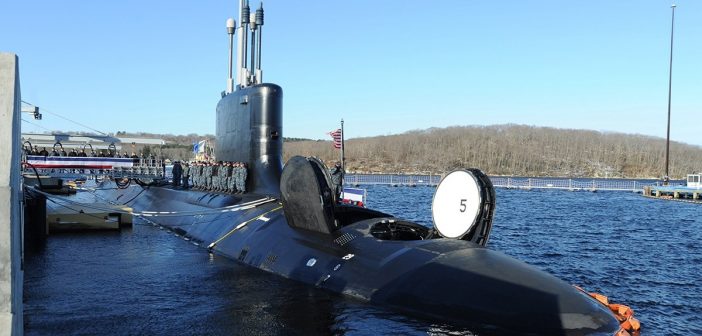There’s No Such Thing as “Only” a Billion Dollars
Now that President Trump has declared a national emergency to build his border wall, all eyes are on what will be cut to free the additional $7.5 billion he wants as a down payment for the project.
Rather than the wall, that money would be better spent on buying new systems and capabilities the United States desperately needs as it faces rising global powers.
Trump’s wall funding would come from appropriated, un-obligated accounts and be in addition to nearly $1.4 billion Congress approved for border fencing last week in the spending measure Trump signed to avert another government shutdown.
That means the first border wall installment will total some $9 billion dollars, up from $5.7 billion Trump demanded after House and Senate Republicans late last year gave him $1.6 billion, precipitating the longest partial government shutdown.
Of the the new $7.5 billion, $3.6 billion will be pared from military construction, $2.5 billion from counternarcotics, interdiction and counter-terror accounts, $600 million from the Treasury Department’s forfeiture fund, and the rest elsewhere in the federal budget.
It’s unclear how much Trump’s full border wall will cost, but three things are clear — it will likely be more expensive than the $25 billion supporters claim, is of questionable value, and Mexico won’t pay for it.
Given American taxpayers will foot this whopping bill, it’s an appropriate time to reconsider priorities and the value of money.
Throughout the shutdown, wall supporters argued $5.7 billion was affordable in the context of a $4 trillion federal budget.
It’s true that in comparison, the amount for the wall appears trivial until you realize the absurdity of that metric. The question is — what else you could get for that money that would be more important to national security.
There is no such thing as only a billion dollars. That’s enough money to give 35,000 Americans a full-time job at average wages.
Leadership is about setting thoughtful priorities and making tradeoffs.
Every nation has an obligation to protect its borders, but the notion that spending arbitrary sums for their own sake, whether on a wall or any other priority, is ridiculous.
There’s much America can do to improve border security, including surveillance, more efficient interdiction, physical barriers where necessary as well as more inspectors, agents and immigration judges.
That said, there is no crisis at the border. Migration to America from its southern border has been dropping for decades and is now lower than it’s been in 20 years. Even legal immigration is declining.
The wall is popular with the president and his base, but opposed by more than 60 percent of Americans because more than 80 percent of migrants as well as human and drug traffic enter the nation via ports of entry rather than unwalled tracts of borderland. Why? Because for those doing the smuggling, it’s less expensive to sneak people and drugs through ports of entry than haul them into the middle of nowhere where they are easier to intercept.
And if the threat from drugs, migrants and terrorists across the southern border is so serious, cutting funding for such program to help underwrite the wall doesn’t make much sense.
America’s ability to spend is finite, especially as Washington is adding $1 trillion a year to a national debt that stands at a record $22 trillion. Assuming interest rates remain constant, merely servicing that debt is likely to cost — by the mid to late 2020s — as much as the Pentagon’s annual budget. That, in turn, benefits China, which holds more American debt than any other foreign power.
In this era of rising competition with China and Russia, each dollar Washington spends must be invested in new capabilities, concepts and systems in sufficient numbers to deter Beijing, Moscow, Pyongyang or Tehran by raising their stress levels.
Instead of expending precious resources on a wall of dubious utility, how about investing $7.5 billion this year — and whatever else would be spent for the wall — on systems that keep US adversaries awake at night. Despite rising defense spending, both the Air Force and Navy are stil too small for sustained combat operations against a peer competitor, so the added money would allow both to grow their forces.
And few things raise Chinese anxiety more than America’s submarines and Air Force’s stealth and reconnaissance aircraft — especially as they move around Asia.
For $7.5 billion, the Navy could buy three new attack submarines, several destroyers or amphibious ships, up to seven new frigates or cover half the cost of a new Ford-class aircraft carrier.
The Air Force could buy a dozen more B-21 Raider stealth bombers or another 75 much-needed F-35 Lighting II fighters.
That sum would buy a lot of new armored ground vehicles, bolster smart munitions and air and missile defense weapons.
Or it could be be invested in other higher priority areas like artificial intelligence, cyber security, electronic warfare, hypersonic and space systems. Or breaking the logjam of backed-up security clearances.
The Coast Guard, for its part, could buy all six heavy and medium Polar Security Cutters it needs as well as modernize its aging inland buoy tender fleets — with billions left over.
Or that money could be invested in the infrastructure upgrades the nation needs to improve the readiness of its forces.
Instead, it’s the Pentagon’s military construction account that will be raided for the wall. DoD officials are now deciding what to cut from $20 billion or so in appropriated, but un-obligated, military construction funds.
While the military construction budget is criticized for its porkbarrel attributes, it is critical to generating readiness by replacing dilapidated housing, improving aging facilities and preparing yesterday’s bases for tomorrow’s game-changing new systems.
With a smaller fleet that has had to run ever harder until it grows, the Navy has a 20-year, $21 billion plan to improve ship support and repair capabilities core to generating readiness. With ship and submarine maintenance backed up, the service has been on a drive to recruit and train new shipyard talent, invest in new facilities and outsource work to private yards to catch up.
Dry-docks and repair facilities worldwide must be upgraded, including with specialized gear to support new capabilities, like the flexible payload modules being fitted aboard all new Virginia-class attack submarines. The two large-diameter tubes can accommodate a range of weapons and new undersea systems, but new equipment is needed to load them.
The Air Force is preparing its air bases for new aircraft like the F-35, KC-46 Pegasus tanker, the B-21 and the new T-X trainer.
The Army and Marines are bolstering their forward presence worldwide, including establishing a prepositioning base in Poland to better deter Russia or ensure in the event of a crisis.
However hard DoD leaders work, the offsets for the wall could have an impact, whether on troop quarters or facilities.
The nation can afford a wall. The question is whether it is the best investment of America’s finite resources when future funding is uncertain and it must rebuild capabilities as it faces rising competitors.
There is a long list of far higher priority things to spend money on than a bigger border wall.




